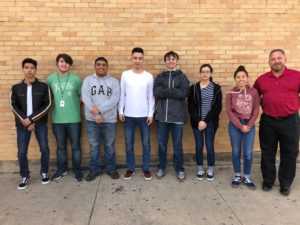
Image Credit: Irving Independent School District
By: Rachel Hawkins, NDG Staff Writer
When you get on an airplane, it’s most likely the last thing you’re going to think about in the midst of checking your over-weighted luggage, being held up by TSA, and the chaos of finding your flight on time is the mechanics of flight and how it works.
But luckily for some Irving students, they are taking a whole new meaning to taking flight.
Only offered at Irving High School through their aviation science program, these students are gaining the unique chance and experience to learn about different types of aviation, how they work, and why.
Craig Heckel is the program’s coordinator for the Irving High School of aviation science.
The program started in 2012 when the aviation industry was looking for more people to join the field.
“The industry is trying to grow, and it can’t grow because there are not enough people coming in the front door to match the people who are going out of the back door,” Heckel said. “The industry was recognizing that, and they were going to the colleges to do recruiting but that wasn’t good enough. So now they are going to the high schools to start these programs to get people interested, and let them know there is a huge umbrella of aviation that you can work in electronics, computer programming, or be a fireman under aviation.”
Many airlines came to Irving High School to ask “what can you do?”
The program is open from ninth through twelfth grade. Everyone starts off by taking principles of aviation in ninth grade. In tenth grade, they will begin to expand more in-depth on various aviation concepts.
At the end of the tenth-grade students can choose which track they would like to pursue for their final two years. They can either choose from drone engineering, flight, and then the mechanical side.
“We teach about everything,” Heckel said. “In their freshmen and sophomore year, we look at GPS, learning how to fly, various principle, and Newton’s laws. So all of the things that affect aviation.”
As well as learning different aspects, students will also have the opportunity to have hands-on engagement.
“In some cases, I had the students build the equipment like wind tunnels so they can actually get the experience of seeing it,” Heckel said. “They will see how it works, and when you put something in it, and how it’s affected. We have all the normal tools. We have a full workshop in the back for making things.”
The students will use everything from bandsaws to electronics with soldering irons.
Angie Maravi, a junior at Irving High School, takes drone engineering at the school. She is highly interested in drones and wants to go into aeronautical engineering.
In her class, she will usually use a computer-aided design system to make digital 3D models.
“For example, right now we are working on UAV, an unmanned aerial vehicle,” said. “We also do a lot of research about what is going on in the industry. We also do research from the past. One example is from the 1990s there were a lot of aircraft crashes happening. So Mr. Hec would talk to us about the importance of communication between captains and officers.”
Heckel stated he loves to have his students dig for topics which interest them to get them more involved and excited.
Each year the student will work on a Real Life Design Challenge. This is when the students are given a set of parameters and software and will work together in teams to take on real-world engineering challenges. They are able to make their own design where they will present it to the state first and if they succeed they will go on to nationals.
In the first year of competing, they were named the best team in the state while advancing to the national competition in Washington D.C. They were then named the Best First-Year Team.
This year they won state for the second year in a row.
Since the students have different classes they are hardly ever together to work on the project. Instead, the hold after-school meetings where they would work on the project at different times.
Right now for their real-world design challenge, they are working on supervising the plant health of urban areas.
“We have to build our own UAV design analysis,” said. We decided to do a hybrid, which is basically a drone and a fixed-wing aircraft. I am the design analysis manager and I am the one who does the math behind it. I really love the math and science behind it.”
In the program, there are several components involved. This can range from math, science, communication, and teamwork.
“I haven’t really done a lot of it this year, but I like for them to look at accidents because I believe we can learn so much from it,” Heckel said. “Also, safety is huge. There are two lessons I teach first, safety and ethics. They don’t really get a lot of ethics, and this being a career in technology education, we’re focused on running this very similar to a job.”
Just how a real aircraft is built in places all over the world, the students will work on separate parts of their aircraft in groups to build in sections and then bring it together.
The students can also get a certification in safety through the program which will start later in the semester. Students can obtain this certification as short as a week.




